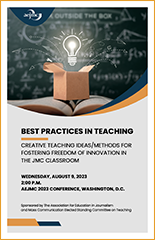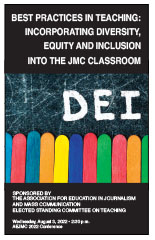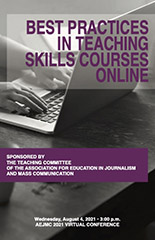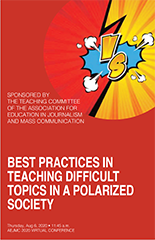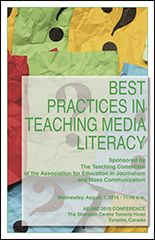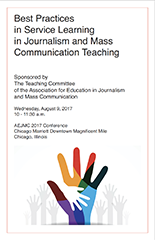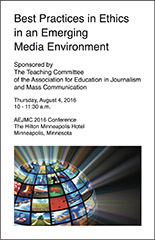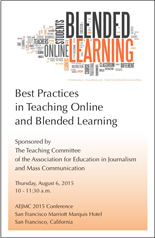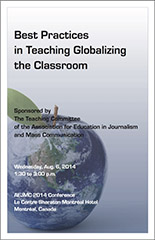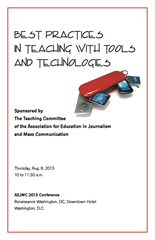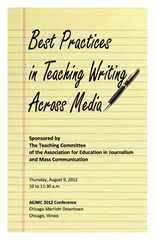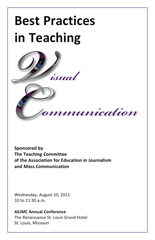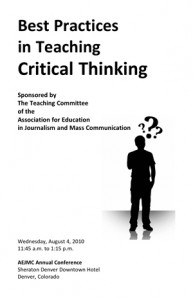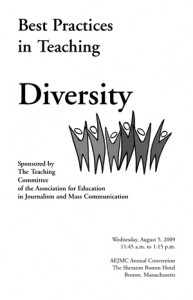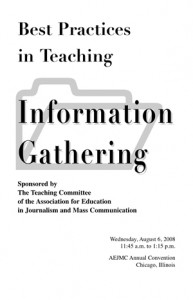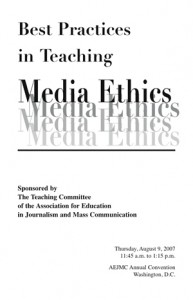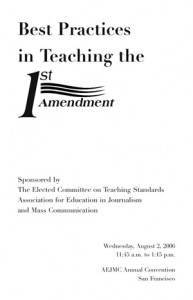Tips from the AEJMC Teaching Committee
Atypical Tips
 By Kevin Williams
By Kevin Williams
AEJMC Standing Committee
on Teaching
Mississippi State University
(Article courtesy of AEJMC News, March 2021 issue)
Listen. I’ve got nothing for you here. Who am I to tell you how to be a better teacher? If you see a colleague in a class do something different that excites you, then do that thing. Yet, I would be derelict in my duties if I didn’t offer you tips to improve your teaching. So here are three vapidly random things you should try.
1. Make sure you have a VPN program on your computer. This way, you can connect to the campus network from home and print out whatever you need for class the night before. When you’re running late to class the next day, at least you won’t have to deal with 20 people tying up the printer.
Of course, this is assuming you’re still allowed to print after the budget cuts. Many of us work at prestigious universities where we don’t have to focus on market competition. The rest of us, however, are told to behave like poachers patrolling the Serengeti. Recently, I listened to a presentation from an administrator asking if we are “student ready” as opposed to demanding our students be “college ready.” In other words, are we prepared to meet students head on who may have been unprepared for college or have disadvantages putting them at risk for dropping out?
I get it. Am I recognizing the needs of students different from me and am I doing everything I can to promote success in my classroom? I wrestle with this because there is another side of me that worries I may be lowering expectations and standards too much. Am I going to be that professor who becomes more lenient, playing to the audience to gain favor? Dear Lord, there’s nothing worse than an aging hipster!
2. Get a new coffee mug. Yeah, yeah, I’m sure you wash it but the daily stains from your coffee make it look like Pig‐pen from Charlie Brown took a bath in it. You know it’s clean but it still looks nasty to a student who drops by for office hours.
Of course, this is assuming you still hold hours in your campus office. This pandemic has given us a glimpse at how extremely difficult the future may be. So many people talked like all the bad stuff would stop once we hit 2021. Truth be told, the genie is out of the bottle. While administrators may say they are ready to return to normalcy, there is no returning to Neverland. We must adapt. I’m not talking about adopting a new textbook or learning the latest Adobe revisions. This was a full‐scale sea change. Established teachers had to get uncomfortable and respond to change. For those just starting your careers who were more at ease, be ready when your moment comes. Face that anxiety and realize that you still control the classroom.
3. Always carry stain remover wipes with you for spills on your clothes and always carry a handkerchief or tissues.
Of course, you are a master instructor beyond the reproach of students. You’re still going to spill orange chicken sauce on that shirt or blouse. Be prepared. You’re only human. And so are your students. Do we complain about entitled Millennials? Yes! However, like you, they are also still a work in progress. Many of them were dropped off at college by parents with an unstated expectation that you will take care of things from there. You are the steward of those parents’ most valuable possession.
To many students, you are going to be the most constant adult with whom they interact. They are going to see you at least 3 hours every week. You may be the first person they think of when they encounter a problem too uncomfortable to tell their parents. You don’t have to fix them, but you do have to be human and point them to the help they need. I’ve had a few students come to me crying about things other than grades. Have a tissue for them. Carry a handkerchief, too, because some days you may not have enough tissues.
Since becoming a professor, I’ve encountered students dealing with losing everything in Hurricane Katrina, an active shooter on campus, the long illness and passing of a colleague, and the deaths of too many of my colleagues’ children. As I write this, I’m looking at a photo on my desk of my father who busted his knuckles and knees every day to make sure I was the first in the family to graduate from college. Three months ago, he began his battle with dementia. Find efficiencies, clean up after yourself, be both flexible and demanding, and carry a handkerchief. Beyond all else, stay human. Sometimes the vapidly random things are nearly too heavy to bear.
Tips from the AEJMC Teaching Committee
Being a Crash Test Dummy for My Students
 By William C. Singleton III
By William C. Singleton III
AEJMC Standing Committee
on Teaching
University of Alabama
(Article courtesy of AEJMC News, January 2021 issue)
My fellow Ph.D. graduate teaching assistants (GTAs) and even
some of my professors tell me I shouldn’t.
“That’s not wise.”
“You’re inviting trouble.”
“Keep your distance.”
“I wouldn’t do that.”
In many academic publications that offer tips for teaching professionals, it’s not advised.
That I don’t have my own office with a university phone doesn’t help matters. This plus the fact I want my students to understand they’re going into a career in which they must professionally bother people.
So, at the beginning of each semester, I give my students my cell phone number and tell them if they have any questions about a story assignment, AP Style tests or anything pertaining to the class, they can call or text me at any time. Of course, I admonish them to be wise about when to call (“At 1 a.m., you’re likely to be greeted with sleep babble.”), but I don’t want them to be shy about asking questions if they don’t know the answers – a fundamental curiosity they’ll need to succeed as reporters.
Then, I provide the reason I’m entertaining their inquiries and opening myself up to be bombarded by calls and texts throughout the semester: if you’re scared to ask questions of your sources and the questions you didn’t ask manifest as holes in your story, a meticulous but ornery editor is likely to demand you call your sources back and get answers to the questions you should have asked the first time.
And your cranky editor likely won’t care if you have to arouse them from a sound sleep – the type that results in incoherent rambling. “Trust me, I’ve been the one who’s had to make that call,” I say. “So I’m your crash test dummy. Start practicing this skill with me.”
Surprisingly, of the five classes I’ve taught, no student has ever called me, and only a few have texted me. I don’t know whether this has to do with “fear of the instructor” or if students are less inquiring than in previous generations, but it is somewhat disappointing, particularly the aspect of not wanting to talk through questions. I’ve noticed that more students prefer to email questions, but even those students represent a small percentage of the 30 to 40 aspiring journalists I teach per class, per semester.
I guess my naivete will wear off one day when my approach backfires and my cell number becomes a part of some elaborate prank or when I receive a full‐time professorship with my very own university phone. Until that day, I walk the path of the graduate teaching assistant, experimenting and learning as I go.
This idea of being the crash test dummy may be unappealing to those with or working on their Ph.D.’s. Obtaining a degree at the highest level of academia entitles one to the professional respect and courtesy that accompanies his and her endeavor. But, in a general sense, being the crash test dummy means providing experiences in class that will ready students for the real world of journalism. Even our mistakes – and theirs – can be great teaching tools to introduce students to real‐world scenarios and experiences that can help them avoid later pitfalls. And I don’t mind playing the role of the crash test dummy to sharpen their fledgling journalistic skills before they get on the road of life and career.
Among my approaches is that I inform students that they can challenge me on grades as they relate to their story assignments. I tell them if I kill one of your story ideas or you think your story deserved a better grade, you can make your appeal. I’m going to defend my position and explain why I gave you your grade, I say. But I want you to learn to stand up for your work because that’s what you’ll need to do when you pursue stories as journalists. And your news editor won’t always see eye‐to‐eye with you on a story idea. I rarely have students take me up on this challenge.
But one young woman did. I could tell she was nervous because she was trembling as she explained why she should receive a better grade on her story. And I gave her a better grade simply for stepping out of her comfort zone. I felt it was just as important to journalism education for her to learn to approach people she may not want to confront as it is to understand subject‐verb agreement.
Also, because I’ve spent much of my journalism and public relations career in Birmingham, I’ve developed a number of professional contacts I call upon when I need guest speakers for my class. I enjoy supplementing my teaching with media professionals because it reinforces points I’ve made in class and because it gives my students an opportunity to pick the brains of someone currently working in the business, and, more important, gives them the opportunity to make a professional contact. During one visit, a media professional asked for a volunteer to help him role‐play an interview. None of my students responded. I later told them that was a golden opportunity for them to stand out and make a professional contact. Sometimes I wonder if I’m like Charlie Brown’s teacher speaking unintelligibly to my students. Then, I receive an encouraging correspondence that makes it all worthwhile – a thank you email from a student who took me up on my offer, reached out to one of my guests, maintained contact and now has an internship at his television station. (#mesmiling)
As the commercial goes, you CAN learn a lot from a dummy.
Tips from the AEJMC Teaching Committee
Testing Tolerance Offers Teaching Tips for Classroom Controversies
 By Tracy Everbach
By Tracy Everbach
AEJMC Standing Committee
on Teaching
University of North Texas
and
 By Candi Carter Olson
By Candi Carter Olson
AEJMC Standing Committee
on Teaching
Utah State University
(Article courtesy of AEJMC News, October 2020 issue)
What happens when a student in your class discusses her own sexual assault? How do you moderate a classroom discussion on Confederate statues on campus or in the community? What do you do when a student asks questions that are offensive to other students? How do graduate instructors handle hot‐button student discussions?
We aim to answer these questions and provide a guidebook for instructors in our new book, Testing Tolerance: Addressing Controversial Topics in the Journalism and Mass Communication Classroom, published by Rowman & Littlefield. It’s part of the AEJMC Master Class Series (see p. 19). As former heads of the AEJMC Commission on the Status of Women, we conceived this book from a teaching panel we hosted for several years at the AEJMC annual conference in which we discussed gender, race, sexuality, disability, mental health and other topics. Several of those panelists contributed chapters to our book. Each chapter is designed to tackle specific issues, problems, and discussions instructors and administrators might have to handle.
• Candi Carter Olson writes about teaching media literacy and its importance in addressing race, class, gender, disability, sexuality and other differences. Her chapter walks readers through three exercises, each increasing in the discomfort students may feel, and recommends ways to help students through the exercises.
• Tracy Everbach focuses on how to manage controversy and conflict in the classroom. She has been teaching a class on race and gender in the media for more than a decade and offers answers to the question, “How do we discuss highly emotional personal and political topics in a civil, intellectual manner?”
• Meredith Clark offers strategies to manage the emotional labor that faculty of color face on primarily white campuses. She discusses the invisible labor involved in supporting students and fighting for social justice while completing the everyday work expected of tenure‐track professors.
• Chelsea Reynolds provides advice for navigating the increasing mental health issues that both students and faculty are feeling across college campuses. She leads readers through her proactive approach to mental health in the classroom.
• Rebecca Hains, who has extensive experience as a public intellectual on the internet, gives practical advice for other instructors and writers on coping with and handling online harassment. She focuses on how to protect one’s mental health, reputation and job when attacks come from the digital public sphere.
• Former AEJMC President David Perlmutter offers an administrator’s perspective on public perceptions of university employees. He discusses the balance that administrators must strike between the public and the institution, which can create high levels of stress and strain on university leaders.
• Marquita Smith and María Len‐Ríos provide practical advice on engaging students by flipping the classroom and by using the “difficult dialogues” framework to address critical examinations of race, gender, class, sexuality and other sensitive topics.
• Steve Fox gives tips on how to tamp down the classroom and student media “bro culture” that permeates sports journalism and outlines his advocacy for women students and sports journalists.
• Meg Heckman addresses pressures on advisors regarding campus sexual abuse and mandatory reporting requirements. Instructors are being forced to reveal information students give them in confidence, and she offers specific advice and resources for advisors.
• Three leaders from the Native American Journalists Association (NAJA) discuss approaches to teaching and reporting on Indian Country. Victoria LaPoe, Lenzy Krehbiel‐Burton, and Rebecca Landsberry outline how to accurately portray tribal communities, with the goal of reducing stereotyping and erasures of Native identities and perspectives.
• Laura Castañeda takes on “mansplaining,” which is the act of over‐explaining something to a woman in which she is an expert. She offers class activities to draw attention to and prevent the phenomenon.
• Khadija Ejaz discusses the ways that identity, student perceptions, and instructor authority collide in university classrooms for new graduate students teaching courses. She shares personal reflections and those from other graduate students on teaching difficult topics for the first time, especially as a woman and a racial or ethnic minority.
• Nathian Rodriguez focuses on ways to use mediated texts of LGBTQ+ representations to foster discussions of intersectionality in classrooms. He suggests various pop culture texts, including videos, podcasts, streaming shows, and music, through which to do so.
• Paromita Pain offers ways to create a classroom environment that supports and encourages intersectional conversations. By breaking it down, she makes intersectionality approachable and usable by both students and professors.
Finally, we provide resources for teaching tolerance, including books, videos, films, academic journal articles, popular articles, and interactive online projects, and offer tips and tricks for making your classroom a safe and challenging space for approaching tough topics.
For details on how to order Testing Tolerance and other books in the AEJMC Master Class Series, and receive a 30% discount, please visit: http://www.aejmc.com/home/resources/master-class-publications/
Teaching Tips Corner: From the AEJMC Teaching Committee
Articles explore teaching topics of interest to journalism educators. These articles, written by members of the elected Committee on Teaching Standards, were featured in past issues of AEJMC News, the association newsletter.
March 2021 • Atypical Tips • By Kevin Williams, Mississippi State University
January 2021 • Being a Crash Test Dummy for My Students • By William C. Singleton III, University of Alabama
October 2020 • Testing Tolerance Offers Teaching Tips for Classroom Controversies • By Tracy Everbach, University of North Texas and Candi Carter Olson, Utah State University
July 2020 • Media Literacy as a Way of Living • By Ralph Beliveau, University of Oklahoma
March 2020 Article • Service Learning in Journalism & Mass Communication • By Emily T. Metzgar, Indiana University
January 2020 Article • Make the 2020 Election a Teachable Moment • By Marcus Messner, Virginia Commonwealth University
July 2019 Article • Documenting and Demonstrating Quality Teaching • By Amanda Sturgill, Elon University
March 2019 Article • Infecting Students with the Research Bug • By Raluca Cozma, Kansas State University
January 2019 Article • Learning to Teach, Finally • By Mary T. Rogus, Ohio University
March 2018 Article • Five Tips to Make the Second Half of Your Class Better than the First • By Jennifer Jacobs Henderson, Trinity University
January 2018 Article • Some Thoughts on Advising • By Natalie Tindall, Lamar University
November 2017 Article • Strategies for Leading Discussions of Race and Diversity in the Classroom • By Karen M. Turner, Temple University
September 2017 Article • Are your students jittery, jaded or jazzed after the first day of class? • By Carol Schwalbe, University of Arizona
July 2017 Article • Drones: Just Another Tool • By Mary T. Rogus, Ohio University
March 2017 Article • Facilitating a Conversation about Race • By Karen M. Turner, Temple University
January 2017 Article • What Did We Learn? • By Earnest L. Perry Jr., University of Missouri
November 2016 Article • Turning Students into News Junkies • By Raluca Cozma, Iowa State University
September 2016 Article • Social Media and Social Change: A Lesson in Biased Product Development and Collective Action • By Jennifer Grygiel, Syracuse University
March 2016 Article • Teaching in the Eye of a Storm • By Earnest L. Perry Jr., University of Missouri
November 2015 Article • Capturing Students’ Attention • By Leslie-Jean Thornton, Arizona State University
September 2015 Article • The Device Du Jour Is Changing and Challenging • By Amy Falkner, Syracuse University
July 2015 Article • San Francisco and the Amazing Teaching Race: Get Your #AEJMCPARTAY On! • By Linda Aldoory, University of Maryland
March 2015 Article • Finding Success with Student Evaluations • By Natalie T.J. Tindall, Georgia State University
November 2014 Article • Using Research to improve Teaching Skills • By Catherine Cassara, Bowling Green State University
September 2014 Article • Enroll in Online Courses to Improve Teaching Skills • By Leslie-Jean Thornton, Arizona State University
July 2014 Article • Montreal: The Best Programming on Teaching at an AEJMC Conference • By Linda Aldoory, University of Maryland
March 2014 Article • Rewarding Good Teaching • By Karen Miller Russell, University of Georgia
January 2014 Article • Letting Online Students Know You’re There • By Susan Keith, Rutgers University
November 2013 Article • Incorporating Diversity into Course Curricula • By Anita Fleming-Rife, University of Northern Colorado
September 2013 Article • Transformation Involves Collaboration • By Charles Davis, University of Georgia
July 2013 Article • What are your TLOs for DC? • By Amy Falkner, Syracuse University
March 2013 Article • The Effective Use of Guest Speakers • By Chris Roush, University of North Carolina Chapel Hill
January 2013 Article • Incorporating Websites and Blogs into Your Curriculum • By Chris Roush, University of North Carolina Chapel Hill
November 2012 Article • Tweet up with Your Colleagues • By Amy Falkner, Syracuse University
September 2012 Article • How to Live on 24 Hours a Day • By Birgit Wassmuth, Kennesaw State University
July 2012 Article • Continuing AEJMC’s Mission 100 Years Later • By Jennifer Greer, Chair, University of Alabama
March 2012 Article • “The Doctors Are In” Slated for Chicago Convention • By Charles Davis, University of Missouri
January 2012 Article • Incorporating “Diversity” into Course Curricula and Class Discussions • By Linda Aldoory, University of Maryland
November 2011 Article • Fun in the Classroom? Seriously, Here’s How • By Amy P. Falkner, Syracuse University
September 2011 Article • Thwarting Trouble: Creating an ethical foundation through a good syllabus and meaningful conversation • By Bonnie J. Brownlee, Indiana University
July 2011 Article • AEJMC Plenary — Grade inflation: Does ‘B’ stand for ‘Bad’? • By Sheri Broyles, University of North Texas
March 2011 Article • Student Attendance: Being Present for the Teaching Moment • By Birgit Wassmuth, Kennesaw State University
January 2011 Article • Top 10 Tips for Great Mentoring • By Debashis “Deb” Aikat, University of North Carolina at Chapel Hill
November 2010 Article • Follow the Syllabus • By Marianne Barrett, Arizona State University
September 2009 Article • How to turn an Intellectual Property “incident” into a teaching moment • By Birgit Wassmuth, Kennesaw State University
July 2009 Article • Honing your teaching skills using the 2009 convention teaching committee sponsored sessions • By Jennifer Greer, University of Alabama
May 2009 Article • Helping your students beyond the classroom • By Jennifer Greer, University of Alabama
Best Practices in Teaching Booklets
The elected Committee on Teaching Standards offers the “Best Practices in Teaching” series booklets. The booklets are created using the winning entries from the AEJMC Best Practices in Teaching Competition. Booklets are distributed at the Teaching Panel Sessions at past AEJMC Conferences. Click on topics below to view digital booklets (PDFs).
